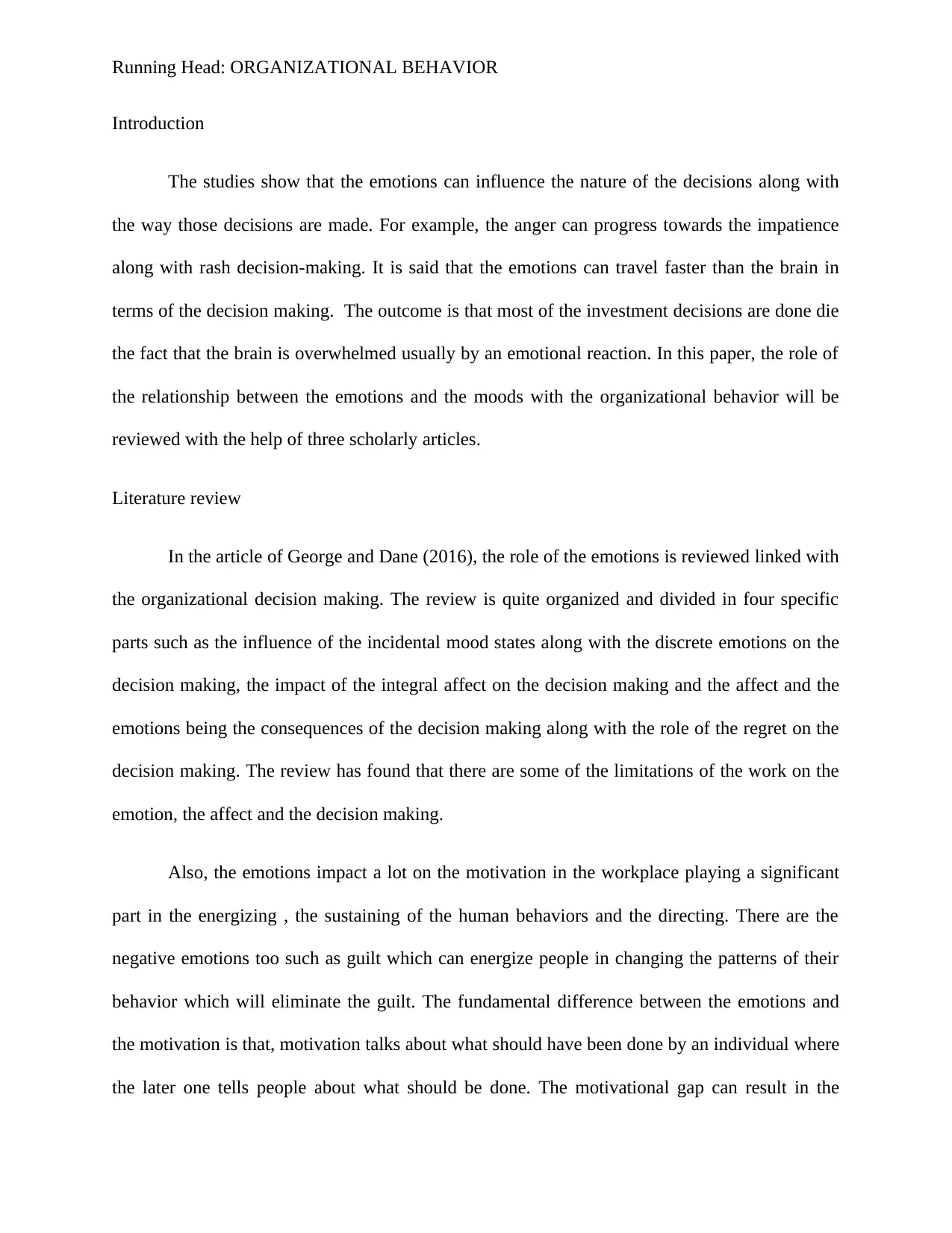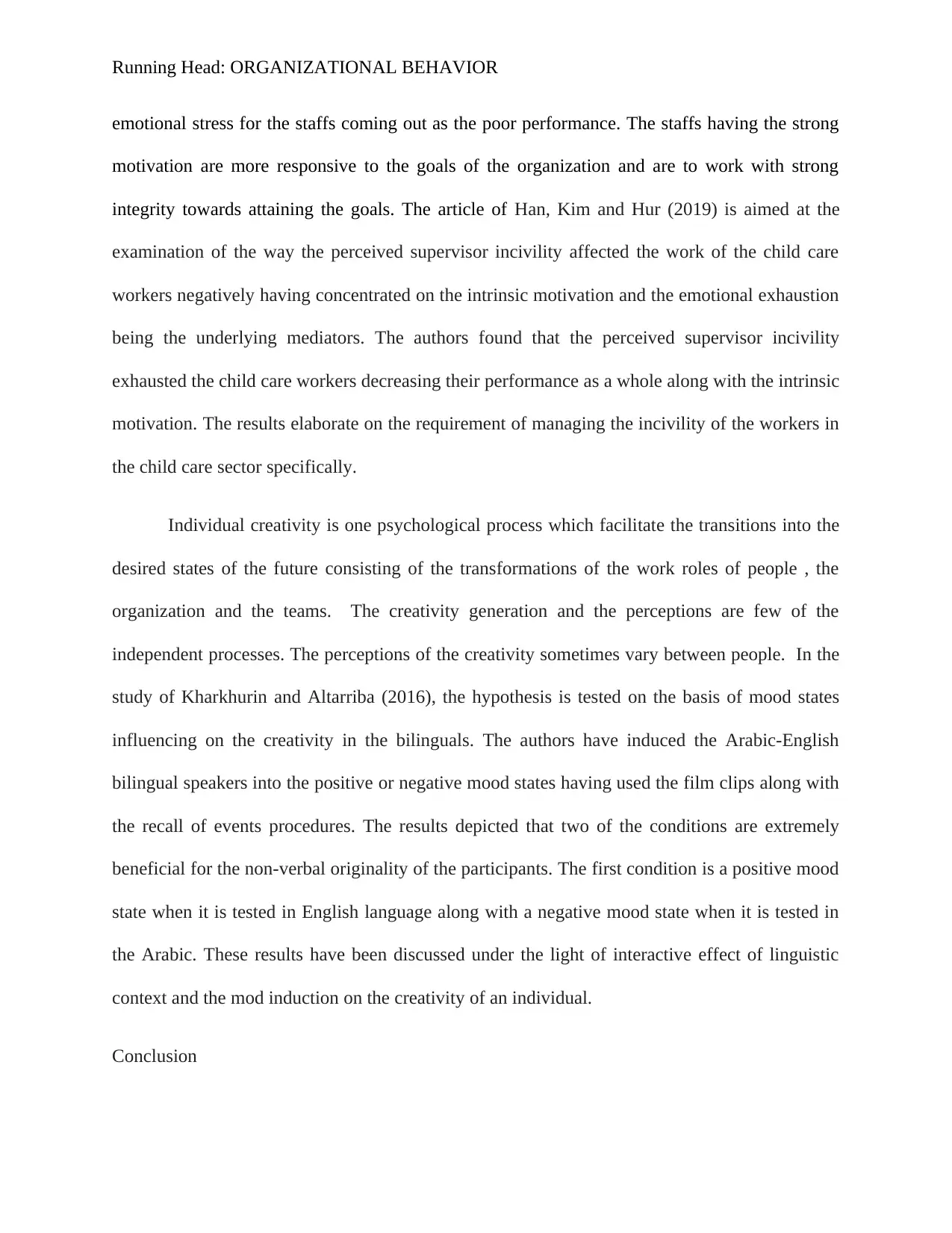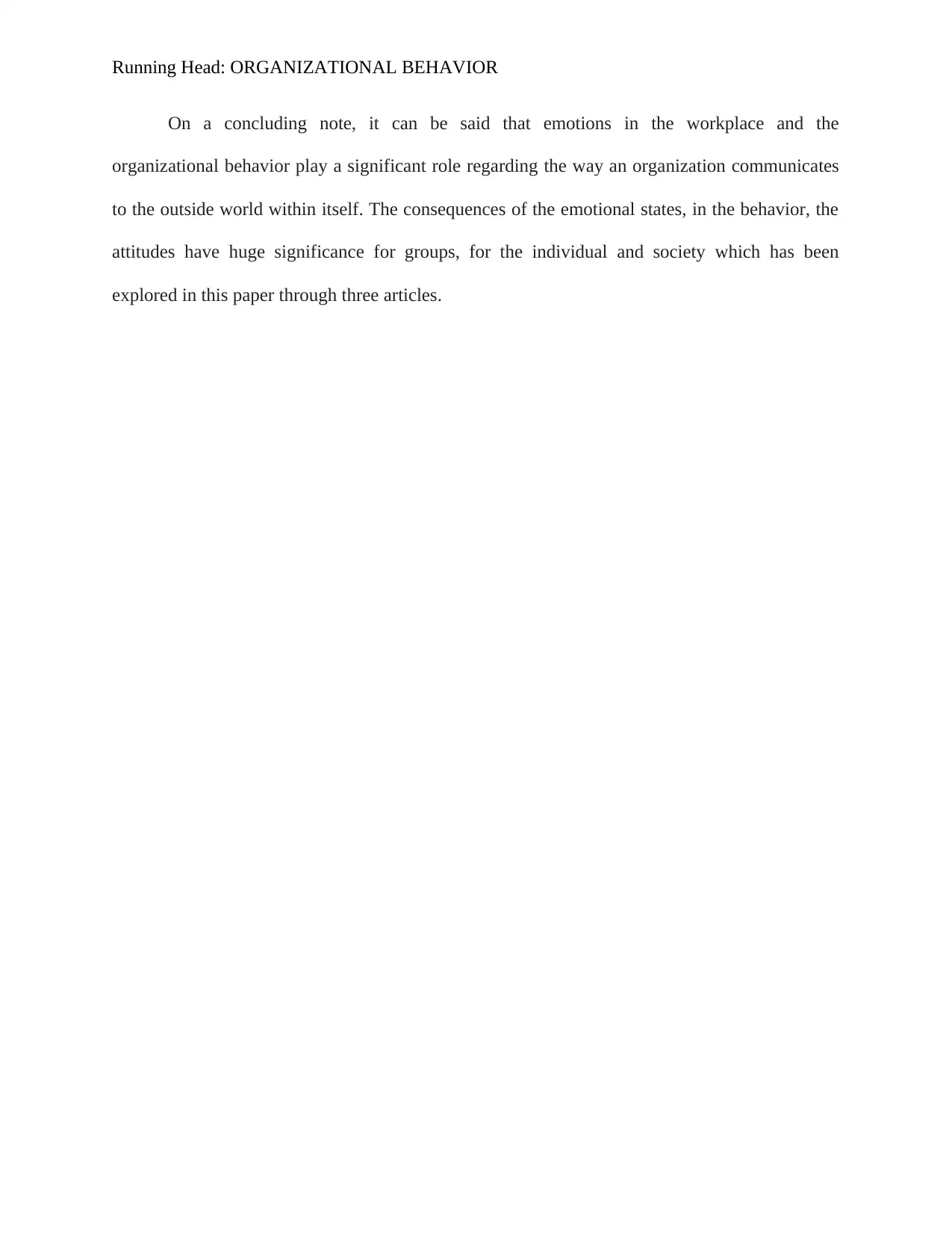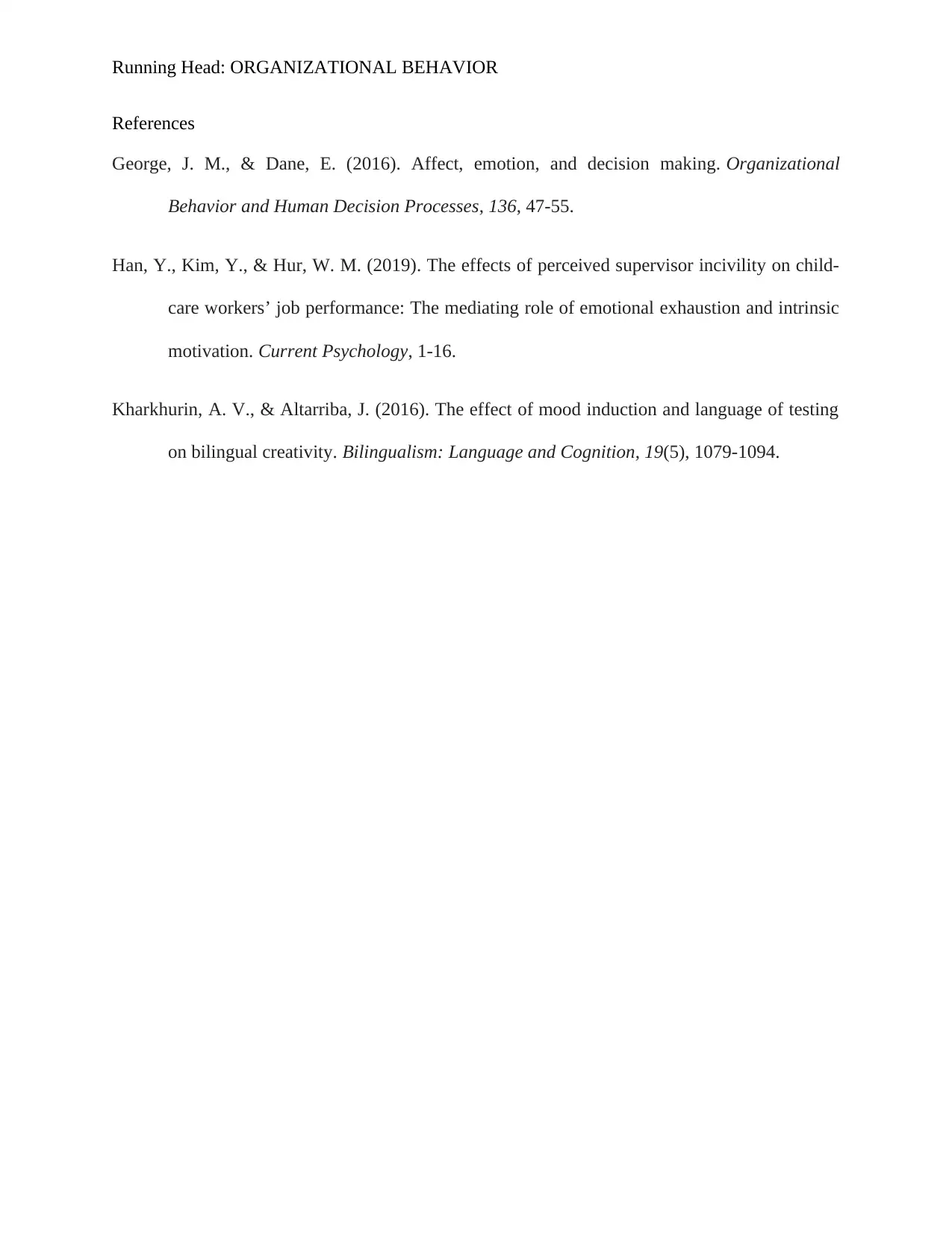The Role of Emotions and Moods in Organizational Behavior: A Review
VerifiedAdded on 2022/09/06
|5
|852
|13
Essay
AI Summary
This essay delves into the intricate relationship between emotions, moods, and organizational behavior, drawing insights from three scholarly articles. It examines how emotions influence decision-making, exploring the impact of incidental mood states, discrete emotions, and the consequences of decisions on affect. The essay further investigates the effects of supervisor incivility on child care workers, mediated by emotional exhaustion and intrinsic motivation, and analyzes how mood states affect creativity in bilingual individuals. The conclusion emphasizes the significant role emotions play in workplace communication and overall organizational behavior, highlighting the impact on individuals, groups, and society.

Running Head: ORGANIZATIONAL BEHAVIOR
Organizational Behavior
Name of the Student
Name of the University
Author Note
Organizational Behavior
Name of the Student
Name of the University
Author Note
Paraphrase This Document
Need a fresh take? Get an instant paraphrase of this document with our AI Paraphraser

Running Head: ORGANIZATIONAL BEHAVIOR
Introduction
The studies show that the emotions can influence the nature of the decisions along with
the way those decisions are made. For example, the anger can progress towards the impatience
along with rash decision-making. It is said that the emotions can travel faster than the brain in
terms of the decision making. The outcome is that most of the investment decisions are done die
the fact that the brain is overwhelmed usually by an emotional reaction. In this paper, the role of
the relationship between the emotions and the moods with the organizational behavior will be
reviewed with the help of three scholarly articles.
Literature review
In the article of George and Dane (2016), the role of the emotions is reviewed linked with
the organizational decision making. The review is quite organized and divided in four specific
parts such as the influence of the incidental mood states along with the discrete emotions on the
decision making, the impact of the integral affect on the decision making and the affect and the
emotions being the consequences of the decision making along with the role of the regret on the
decision making. The review has found that there are some of the limitations of the work on the
emotion, the affect and the decision making.
Also, the emotions impact a lot on the motivation in the workplace playing a significant
part in the energizing , the sustaining of the human behaviors and the directing. There are the
negative emotions too such as guilt which can energize people in changing the patterns of their
behavior which will eliminate the guilt. The fundamental difference between the emotions and
the motivation is that, motivation talks about what should have been done by an individual where
the later one tells people about what should be done. The motivational gap can result in the
Introduction
The studies show that the emotions can influence the nature of the decisions along with
the way those decisions are made. For example, the anger can progress towards the impatience
along with rash decision-making. It is said that the emotions can travel faster than the brain in
terms of the decision making. The outcome is that most of the investment decisions are done die
the fact that the brain is overwhelmed usually by an emotional reaction. In this paper, the role of
the relationship between the emotions and the moods with the organizational behavior will be
reviewed with the help of three scholarly articles.
Literature review
In the article of George and Dane (2016), the role of the emotions is reviewed linked with
the organizational decision making. The review is quite organized and divided in four specific
parts such as the influence of the incidental mood states along with the discrete emotions on the
decision making, the impact of the integral affect on the decision making and the affect and the
emotions being the consequences of the decision making along with the role of the regret on the
decision making. The review has found that there are some of the limitations of the work on the
emotion, the affect and the decision making.
Also, the emotions impact a lot on the motivation in the workplace playing a significant
part in the energizing , the sustaining of the human behaviors and the directing. There are the
negative emotions too such as guilt which can energize people in changing the patterns of their
behavior which will eliminate the guilt. The fundamental difference between the emotions and
the motivation is that, motivation talks about what should have been done by an individual where
the later one tells people about what should be done. The motivational gap can result in the

Running Head: ORGANIZATIONAL BEHAVIOR
emotional stress for the staffs coming out as the poor performance. The staffs having the strong
motivation are more responsive to the goals of the organization and are to work with strong
integrity towards attaining the goals. The article of Han, Kim and Hur (2019) is aimed at the
examination of the way the perceived supervisor incivility affected the work of the child care
workers negatively having concentrated on the intrinsic motivation and the emotional exhaustion
being the underlying mediators. The authors found that the perceived supervisor incivility
exhausted the child care workers decreasing their performance as a whole along with the intrinsic
motivation. The results elaborate on the requirement of managing the incivility of the workers in
the child care sector specifically.
Individual creativity is one psychological process which facilitate the transitions into the
desired states of the future consisting of the transformations of the work roles of people , the
organization and the teams. The creativity generation and the perceptions are few of the
independent processes. The perceptions of the creativity sometimes vary between people. In the
study of Kharkhurin and Altarriba (2016), the hypothesis is tested on the basis of mood states
influencing on the creativity in the bilinguals. The authors have induced the Arabic-English
bilingual speakers into the positive or negative mood states having used the film clips along with
the recall of events procedures. The results depicted that two of the conditions are extremely
beneficial for the non-verbal originality of the participants. The first condition is a positive mood
state when it is tested in English language along with a negative mood state when it is tested in
the Arabic. These results have been discussed under the light of interactive effect of linguistic
context and the mod induction on the creativity of an individual.
Conclusion
emotional stress for the staffs coming out as the poor performance. The staffs having the strong
motivation are more responsive to the goals of the organization and are to work with strong
integrity towards attaining the goals. The article of Han, Kim and Hur (2019) is aimed at the
examination of the way the perceived supervisor incivility affected the work of the child care
workers negatively having concentrated on the intrinsic motivation and the emotional exhaustion
being the underlying mediators. The authors found that the perceived supervisor incivility
exhausted the child care workers decreasing their performance as a whole along with the intrinsic
motivation. The results elaborate on the requirement of managing the incivility of the workers in
the child care sector specifically.
Individual creativity is one psychological process which facilitate the transitions into the
desired states of the future consisting of the transformations of the work roles of people , the
organization and the teams. The creativity generation and the perceptions are few of the
independent processes. The perceptions of the creativity sometimes vary between people. In the
study of Kharkhurin and Altarriba (2016), the hypothesis is tested on the basis of mood states
influencing on the creativity in the bilinguals. The authors have induced the Arabic-English
bilingual speakers into the positive or negative mood states having used the film clips along with
the recall of events procedures. The results depicted that two of the conditions are extremely
beneficial for the non-verbal originality of the participants. The first condition is a positive mood
state when it is tested in English language along with a negative mood state when it is tested in
the Arabic. These results have been discussed under the light of interactive effect of linguistic
context and the mod induction on the creativity of an individual.
Conclusion
⊘ This is a preview!⊘
Do you want full access?
Subscribe today to unlock all pages.

Trusted by 1+ million students worldwide

Running Head: ORGANIZATIONAL BEHAVIOR
On a concluding note, it can be said that emotions in the workplace and the
organizational behavior play a significant role regarding the way an organization communicates
to the outside world within itself. The consequences of the emotional states, in the behavior, the
attitudes have huge significance for groups, for the individual and society which has been
explored in this paper through three articles.
On a concluding note, it can be said that emotions in the workplace and the
organizational behavior play a significant role regarding the way an organization communicates
to the outside world within itself. The consequences of the emotional states, in the behavior, the
attitudes have huge significance for groups, for the individual and society which has been
explored in this paper through three articles.
Paraphrase This Document
Need a fresh take? Get an instant paraphrase of this document with our AI Paraphraser

Running Head: ORGANIZATIONAL BEHAVIOR
References
George, J. M., & Dane, E. (2016). Affect, emotion, and decision making. Organizational
Behavior and Human Decision Processes, 136, 47-55.
Han, Y., Kim, Y., & Hur, W. M. (2019). The effects of perceived supervisor incivility on child-
care workers’ job performance: The mediating role of emotional exhaustion and intrinsic
motivation. Current Psychology, 1-16.
Kharkhurin, A. V., & Altarriba, J. (2016). The effect of mood induction and language of testing
on bilingual creativity. Bilingualism: Language and Cognition, 19(5), 1079-1094.
References
George, J. M., & Dane, E. (2016). Affect, emotion, and decision making. Organizational
Behavior and Human Decision Processes, 136, 47-55.
Han, Y., Kim, Y., & Hur, W. M. (2019). The effects of perceived supervisor incivility on child-
care workers’ job performance: The mediating role of emotional exhaustion and intrinsic
motivation. Current Psychology, 1-16.
Kharkhurin, A. V., & Altarriba, J. (2016). The effect of mood induction and language of testing
on bilingual creativity. Bilingualism: Language and Cognition, 19(5), 1079-1094.
1 out of 5
Your All-in-One AI-Powered Toolkit for Academic Success.
+13062052269
info@desklib.com
Available 24*7 on WhatsApp / Email
![[object Object]](/_next/static/media/star-bottom.7253800d.svg)
Unlock your academic potential
Copyright © 2020–2025 A2Z Services. All Rights Reserved. Developed and managed by ZUCOL.

